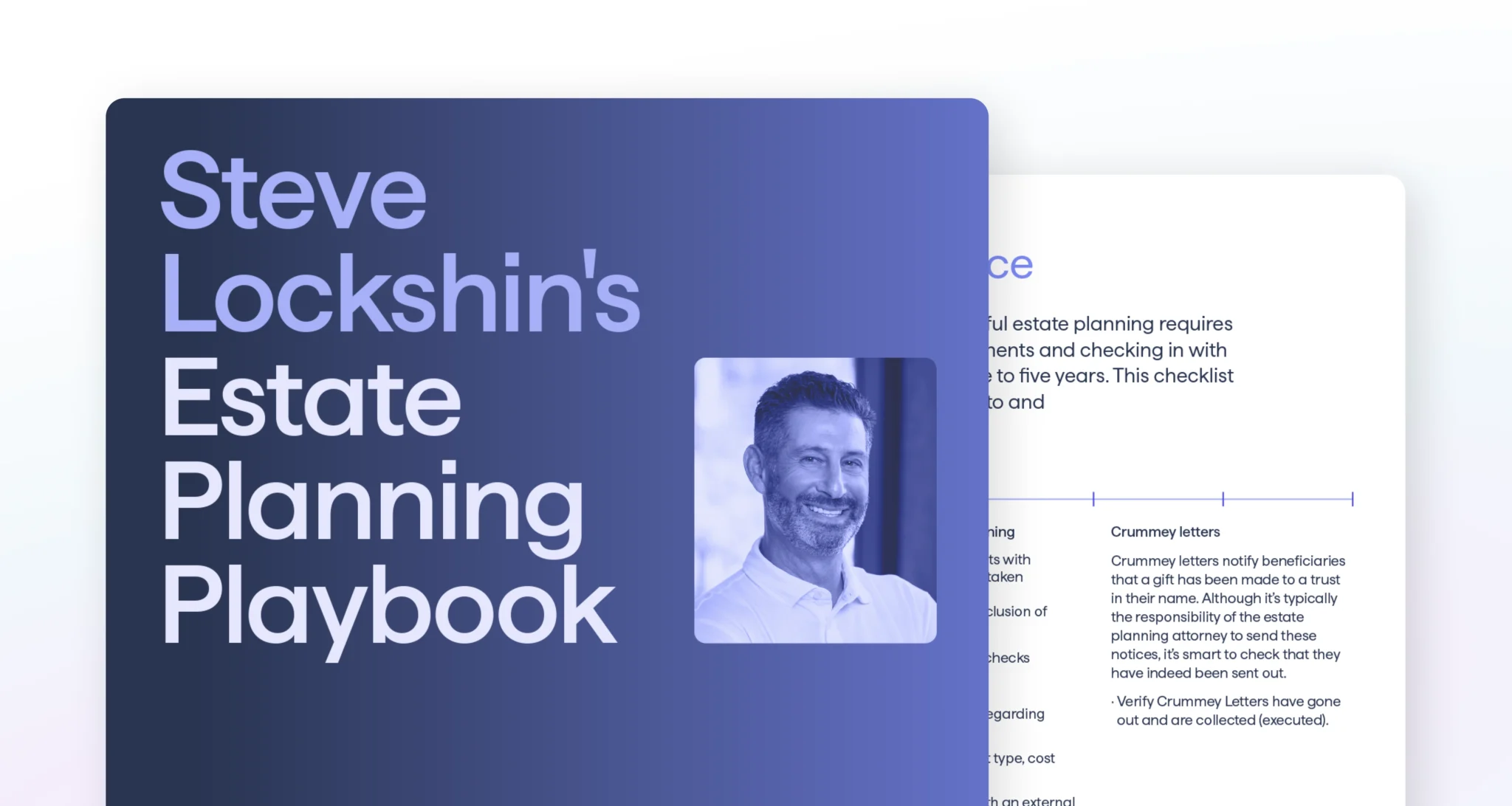 Vanilla
Vanilla
4 Lessons from Steve Lockshin’s Estate Planning Playbook

As an advisor, you probably know how rare it is to retain AUM after the death of the primary wealthholder.
You may also know that there’s a proven way to decrease the likelihood of getting fired when the relationship passes to a surviving spouse or the next generation: estate planning.
Advisors who engage their clients and clients’ families in estate planning are more likely to retain assets as they transfer to a surviving spouse or next generation.
If wading into the waters of estate planning with clients seems intimidating, we have practical advice for navigating these conversations and processes. Here, we’ll share four key lessons from Steve Lockshin’s Estate Planning Playbook for Advisors, which he created based on his 35+ years providing holistic advice to HNW and UHNW clients.
Download the complete playbook here for a deeper dive on estate planning for advisors.
4 key takeaways from the Estate Planning Playbook for Advisors
1. Good visuals are essential for successful client conversations
The playbook breaks the estate planning process down into four phases: Discovery, organizing, visualizing, and strategizing. Each phase is important to successful planning and conversations, but visualization is historically one of the more difficult phases to do well.
Why is visual estate planning so important? Put simply, because most clients (and some advisors) struggle to understand legalese.
A good visualization of the client’s estate plan can turn dense documents into simple diagrams that make it easier to see how assets will move across generations and understand what taxes may be due. However, many advisors aren’t great at actually showing clients what their plan says because they lack the proper tools to do so. If you’re still using a frankenstein-style combination of Excel and PowerPoint to try to demonstrate how a plan flows, it may be time to do yourself and your clients a favor and explore purpose-built estate planning solutions.
2. Don’t be afraid to ask the big questions
Embarking on an estate planning journey with a new client is a huge opportunity to make a meaningful impact on their legacy. It’s a chance to understand your client better and form an even deeper connection with them and their family. There are fundamental aspects of estate planning that should be taken care of as soon as practicable, such as ensuring their core documents are in place and they have sufficient assets or insurance to cover their family’s needs should there be an untimely death. However, as you delve deeper, you will learn that being involved in a client’s estate planning is a very intimate experience that helps to solidify your relationship with your client.
Either as part of the foundational work mentioned above or after completing this work, take the time to understand what your client values. Ask the kinds of big, open-ended questions that allow your client to take stock of what they really care about — and give them the time and space to communicate those values. Your initial meeting shouldn’t be rushed. What is discussed in that first meeting can provide the foundation for how you and your client strategize moving forward.
Examples of these types of questions might include:
- Are there any extenuating circumstances or relationships we’ll want to consider as we plan (e.g. elderly parents, heirs with special needs, etc.)?
- Is it important to protect your heirs from creditors and/or divorce?
- What role does money play in your household?
3. A comprehensive balance sheet is key
To have the most complete, detailed understanding of a client’s situation and planning opportunities, you need a complete picture of their assets. Understanding asset details provides the ability to identify fair market value adjustments, possible restrictions, and to prioritize planning opportunities. Moreover, it’s highly likely you will get insights into assets you may not have been aware existed.
A key part of this is the client’s balance sheet. To be most effective, a client’s balance sheet should include everything a client owns, owes, or expects to receive, regardless whether it’s managed by your firm or not.
Some examples of what should be included in a comprehensive balance sheet are:
- Real property and vehicles: Any land, building, or residence that your client owns or has a mortgage on; Cars, boats, motorcycles, or aircraft
- Bank accounts and retirement accounts: Checking, savings, certificate of deposit, and money market accounts
- Digital assets: Many estates overlook digital assets such as airline miles, credit card reward points, cryptocurrencies, and log-in credentials.
- Investments: General investment account, mutual funds, ETF, stocks (equities), bonds, money market, and Treasury bills.
- Retirement accounts and insurance: General pension, 401(k), 403(b), IRA, Simple IRA, SEP IRA, Roth IRA, HSA, and ESA, as well as life insurance including term, whole life, split-dollar, group life, and annuity
- Promissory notes and anticipated inheritance, gifts, and lawsuit judgments: If your client has loaned money to a family member with a written promise of repayment, it’s crucial that they include the amount in their estate. Or if your client expects to inherit money or receive a financial windfall, help them avoid possible tax penalties by planning ahead
4. Remember ongoing maintenance
It can’t be said too many times: Estate planning is not a one-time conversation. Successful estate planning is an ongoing process that advisors should regularly revisit and update with clients. Major life events like marriages, births, divorces, and deaths are obvious triggers for plan reviews, but it’s still up to you as the advisor to start the conversation about long-term planning when these events occur.
The playbook outlines a suggested timeline for ongoing maintenance for the first and second halves of the year. Of course, each plan’s maintenance will depend on the client’s life events, level of wealth, age, etc., but it’s important to have an overarching framework for regular plan reviews regardless of these factors.
Estate planning isn’t a one-time activity. Doing it right takes ongoing effort on the advisor’s part—but your clients will ultimately thank you for it.
To learn more, download the complete Estate Planning Playbook for Advisors here.
Published: Sep 09, 2025
Holistic wealth management starts here
Join thousands of advisors who use Vanilla to transform their service offering and accelerate revenue growth.
